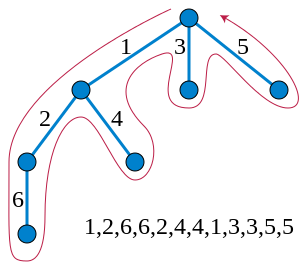PROBLEM LINK:
Setter: Abhishek Pandey
Tester: Taranpreet Singh
Editorialist: This person
DIFFICULTY:
Easy
PREREQUISITES:
Basic Trees, Path, DFS would do the trick.Understanding of Euler tree tour or Binary Lifting would be helpful.
PROBLEM:
Given a tree and location of Tarini X, find if shop P lies in path of Taran T and X.
VARIOUS SOLUTIONS
-
Root the tree on $X$ and just check whether Node $T$ lies in subtree of node $P$ using euler tree tour. -
Root the tree on $X$ and check if $P$ is an ancestor of $T$ using binary Lifting.
EXPLANATION
Since we have a node given, rooting the tree can significantly reduce complexity of our solution.
Suppose we have rooted the tree at some node other than X. Let LCA of X and T be L, then our problem is to find whether P lies on path X to L or P lies on path L to T. If either is positive, answer is true.
Just by rooting the tree at X, we reduced above problem to checking if P lies on path of X to T as LCA (root,T) is root.
Now,
Euler Tour Tree Solution
Euler tour can be defined as the tour of tree in a DFS manner, so as to flatten the tree into an array.

The notable properties of this ordering is that,
- Each vertex is visited exactly twice, one time during entering, and once during leaving.
- Each vertex has a corresponding interval, ranging between entry time ans exit time.
- **Node X is in subtree of node Y if Node Y is entered before Node X and X is left before Node Y. Formally, if st[] denote start time and en[] denote end time, then node X is chid of Node Y is st[Y]<= st[X] and en[X] <= en[Y].
This is all we need to solve this problem using euler tour. Just run a dfs to compute st and en array, thus answering subtree queryies in O(1).
Binary Lifting Solution
We now view the problem in a different manner. Root the tree at X and we need to check if node P is an ancestor of node X.
This a standard binary lifting problem and can be solved as explained by following cases, D[X] denote depth of Node X.
- If D[P] >D[T] ans is NO.
- Else Find ancestor of Node T at same depth as P. If P is that ancestor, answer is YES, else answer is NO.
Bonus Problem
Solve same problem, but X varies with each query.
Complexity:
Euler Tour solution: Precomputation O(N), O(1) per query.
Binary Lifting soluton: Precomputation O(N), O(logN) per query.
AUTHOR’S AND TESTER’S SOLUTIONS:
Setter’s solution
Tester’s solution
Feel free to share your solution or ask any doubts.
PS:There doesn’t exist any person called Tarini, except in mind of Setter.
 .
.  . Not only him, many other, especially div1 coders did henious mistakes like forgetting resetting the counter variable of euler tour, not clearing the list after each test cases, NOT CLEARING VISITED ARRAY EACH TEST CASE. LOL XD. At that time I felt how the leaderboard would be if we used no-feedback system like topcoder where you just submit and you get to know if your solution is correct or not only after contest. XD.
. Not only him, many other, especially div1 coders did henious mistakes like forgetting resetting the counter variable of euler tour, not clearing the list after each test cases, NOT CLEARING VISITED ARRAY EACH TEST CASE. LOL XD. At that time I felt how the leaderboard would be if we used no-feedback system like topcoder where you just submit and you get to know if your solution is correct or not only after contest. XD.